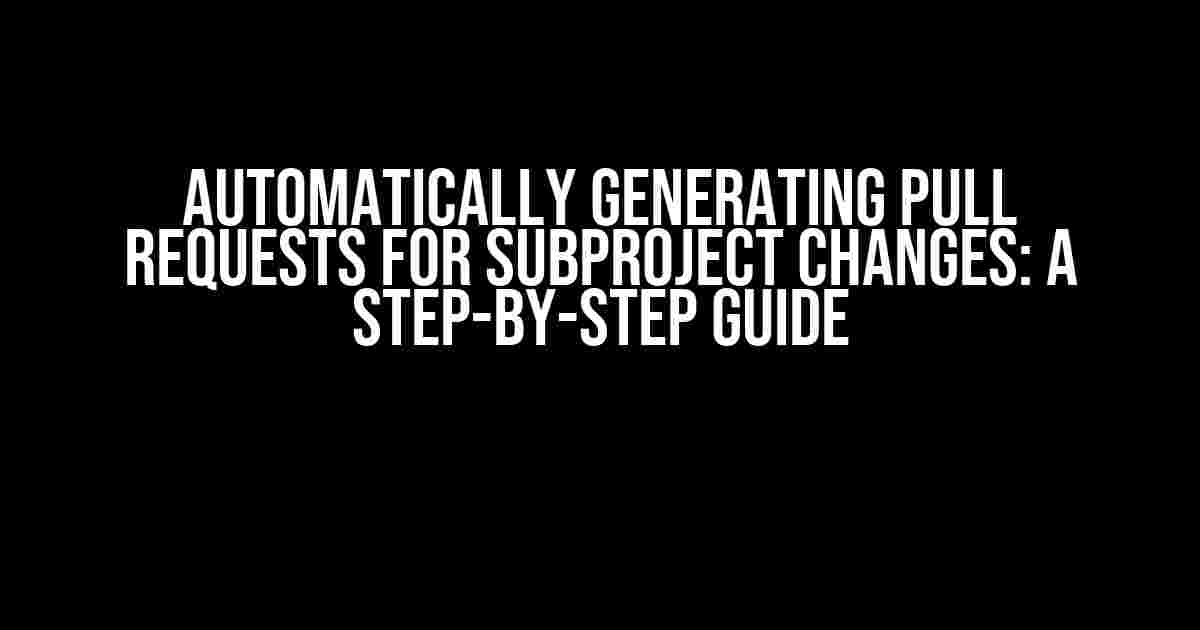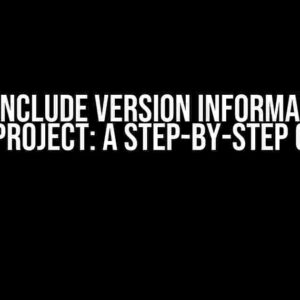Are you tired of manually creating pull requests for subproject changes? Do you find yourself wasting precious time and energy on repetitive tasks? Well, worry no more! In this article, we’ll show you how to automate the process of generating pull requests for subproject changes, freeing up your time to focus on more important tasks.
What You’ll Need
To get started, you’ll need the following tools and technologies:
- Git and GitHub (or your preferred version control system)
- A CI/CD tool like Jenkins, Travis CI, or CircleCI
- A programming language like Python, JavaScript, or Ruby
- A GitHub Personal Access Token with sufficient permissions
Understanding the Problem
When working on a large project with multiple subprojects, it’s common to encounter changes in one or more subprojects. These changes might include bug fixes, new features, or updates to dependencies. However, manually creating pull requests for each subproject change can become tedious and time-consuming, especially if you have multiple subprojects to manage.
The Benefits of Automation
Automating the process of generating pull requests for subproject changes offers several benefits, including:
- Increased efficiency: Automation saves time and reduces the risk of human error.
- Improved consistency: Automated pull requests ensure consistency in formatting and content.
- Enhanced collaboration: Automation enables teams to focus on more important tasks, improving collaboration and productivity.
Step 1: Set Up Your CI/CD Tool
The first step is to set up your CI/CD tool to automate the build and test process for your subprojects. This will ensure that changes to subprojects are automatically detected and built.
# Example Jenkinsfile for automating build and test
pipeline {
agent any
stages {
stage('Build') {
steps {
sh 'npm install'
sh 'npm run build'
}
}
stage('Test') {
steps {
sh 'npm run test'
}
}
}
}
Step 2: Create a GitHub Personal Access Token
To interact with the GitHub API, you’ll need to create a Personal Access Token with sufficient permissions. Follow these steps:
- Log in to your GitHub account.
- Click on your profile picture in the top right corner, then click on “Settings.”
- Click on “Developer settings” in the left-hand menu.
- Click on “Personal access tokens” and then click on “Generate new token.”
- Select the “repo” scope and any other scopes required for your use case.
- Click “Generate token” and copy the token.
Step 3: Write a Script to Automate Pull Requests
Now, you’ll need to write a script that uses the GitHub API to create a new pull request for each subproject change. Here’s an example script in Python:
import os
import json
import requests
# Set your GitHub repository and Personal Access Token
REPO_OWNER = 'your-username'
REPO_NAME = 'your-repo-name'
GITHUB_TOKEN = 'your-personal-access-token'
# Set the API endpoint and headers
API_ENDPOINT = f'https://api.github.com/repos/{REPO_OWNER}/{REPO_NAME}/pulls'
HEADERS = {
'Authorization': f'Bearer {GITHUB_TOKEN}',
'Content-Type': 'application/json'
}
# Define a function to create a new pull request
def create_pull_request(title, body, branch):
data = {
'title': title,
'body': body,
'head': branch,
'base': 'main'
}
response = requests.post(API_ENDPOINT, headers=HEADERS, json=data)
return response.json()
# Define a function to get the latest commit for a subproject
def get_latest_commit(subproject_path):
commit_hash = os.popen(f'git -C {subproject_path} rev-parse HEAD').read().strip()
return commit_hash
# Define a function to generate a pull request for a subproject change
def generate_pull_request(subproject_path, title, body):
branch = f'update-{subproject_path}'
os.system(f'git -C {subproject_path} checkout -b {branch}')
os.system(f'git -C {subproject_path} commit -am "Update {subproject_path}"')
os.system(f'git -C {subproject_path} push origin {branch}')
commit_hash = get_latest_commit(subproject_path)
create_pull_request(title, body, branch)
# Example usage
subproject_path = 'path/to/subproject'
title = 'Update subproject'
body = 'This pull request updates the subproject to the latest version.'
generate_pull_request(subproject_path, title, body)
Step 4: Integrate the Script with Your CI/CD Tool
Now that you have the script, you’ll need to integrate it with your CI/CD tool. This will ensure that the script runs automatically whenever a change is detected in a subproject.
# Example Jenkinsfile for integrating the script
pipeline {
agent any
stages {
stage('Generate Pull Request') {
steps {
sh 'python generate_pull_request.py'
}
}
}
}
Step 5: Configure Webhooks
To automate the process, you’ll need to configure webhooks to notify your CI/CD tool whenever a change is made to a subproject. Follow these steps:
- Log in to your GitHub repository.
- Click on “Settings” in the top right corner.
- Click on “Webhooks” in the left-hand menu.
- Click on “Add webhook” and enter the URL of your CI/CD tool.
- Select the events you want to trigger the webhook (e.g., “Pushes”).
- Click “Add webhook” to save the changes.
Conclusion
Automatically generating pull requests for subproject changes can save you a significant amount of time and effort. By following the steps outlined in this article, you can set up a robust automation process that ensures consistency and efficiency in your project workflow.
| Tools and Technologies | Description |
|---|---|
| Git and GitHub | Version control system and platform |
| CI/CD Tool | Automates build, test, and deployment processes |
| Programming Language | Used to write scripts for automation |
| GitHub Personal Access Token | Used to interact with the GitHub API |
Remember to customize the script and CI/CD tool configurations to fit your specific use case and project requirements. Happy automating!
FAQs
- Q: What if I have multiple subprojects with different dependencies?
- A: You can modify the script to handle multiple subprojects and dependencies by using conditional statements and loops.
- Q: How do I handle conflicts between subprojects?
- A: You can use conflict resolution strategies like rebasing or merging to handle conflicts between subprojects.
- Q: Can I use this approach for non-GitHub repositories?
- A: Yes, you can modify the script to work with other version control systems and platforms, such as GitLab or Bitbucket.
We hope this article has helped you understand how to automate the process of generating pull requests for subproject changes. If you have any further questions or need more guidance, feel free to ask in the comments below!
Frequently Asked Question
Are you curious about automatically generating pull requests for subproject changes? Look no further! We’ve got the answers to your burning questions.
What is the main benefit of automatically generating pull requests for subproject changes?
The main benefit is that it saves time and effort by automating the process of creating pull requests, allowing developers to focus on writing code rather than tedious administrative tasks.
How does automatic pull request generation work for subproject changes?
It works by monitoring subproject changes and automatically creating a pull request when a change is detected. This is usually done through integrations with version control systems like Git.
Can I customize the automatic pull request generation process for subproject changes?
Yes, most automatic pull request generation tools allow you to customize the process through configuration files or settings. This can include specifying which subprojects to monitor, setting up notification systems, and defining the pull request template.
What are the potential limitations of automatically generating pull requests for subproject changes?
One potential limitation is that it may lead to a high volume of pull requests, making it difficult for reviewers to keep up. Additionally, if not properly configured, automatic generation may lead to unnecessary or duplicate pull requests.
Can I use automatic pull request generation for subproject changes in a CI/CD pipeline?
Yes, automatic pull request generation can be integrated into a CI/CD pipeline to automate testing, building, and deployment of subproject changes. This allows for a more streamlined and efficient development workflow.



